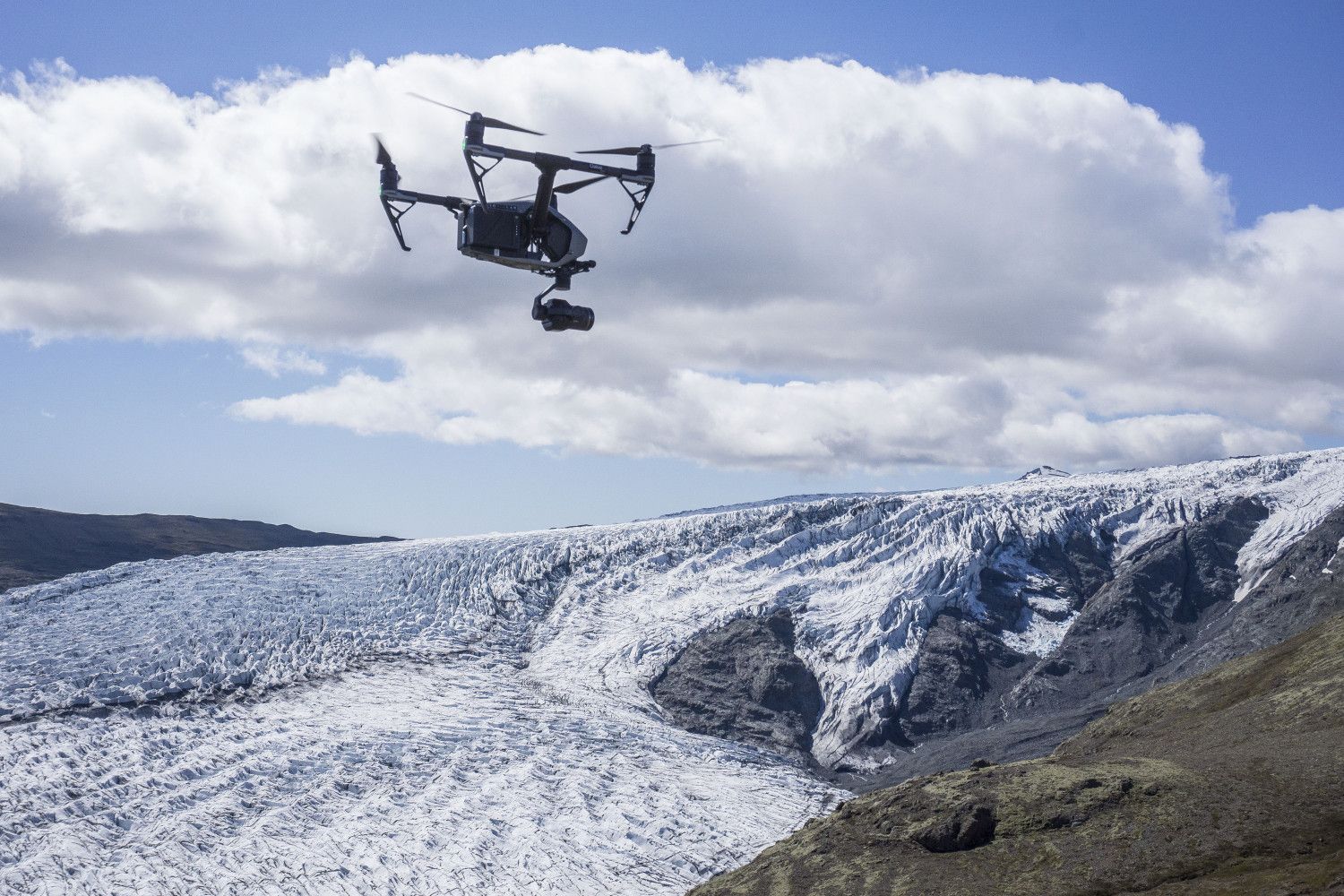An aerial photographer and lecturer in Communication Design at the University of Dundee’s Duncan of Jordanstone College of Art & Design, Kieran is interested in finding novel and creative ways of using digital technologies to visualise landscapes and the stories that they have to tell.
Today, his work – using images from the 1940s and 1980s that were painstakingly reconstructed in 3D and overlaid with current day drone footage – shows how greenhouse gas emissions are causing glaciers to retreat by tens and sometimes hundreds of metres every year.

Going back to his roots
In Iceland, Kieran is quite literally following in the footsteps of his father Colin Baxter, one of Scotland’s most renowned landscape photographers.
In the 1980s and 1990s, on family holidays to Iceland, young Kieran was awed by the sight of the Vatnajökull Glacier. Today, he is using his digital expertise to reveal how bleak the future may be for these remarkable natural phenomena.
Speaking from Iceland, where he is back filming, Kieran says: “I have been studying Iceland’s glaciers for several years now and the rate of their decline never fails to shock me. These new images can make visible the impact that greenhouse gas emissions are having on the natural world.
“These glaciers have grown and shrunk in the past but the accelerated melt that we are witnessing today is unprecedented."
“We can easily lose sight of the scale of these changes which is why we need visual evidence to demonstrate just how destructive global warming can be.”

Family connections
“Growing up, I don’t remember having a particular desire to become a photographer, but there was an indirect influence that left me with a profound appreciation of the outdoors.
“Spending time in those places had a big impact on me. They represent a shared space that connects us, but also a reminder that humans are a small part of a vast system that should be treated with respect.”

Life ‘After Ice’
As part of his research, Kieran teamed up with counterparts at the University of Iceland for a four-year project, which shows the alarming rate at which glaciers in the country’s Hornafjörður region are disappearing. The result, a film called ‘After Ice’, can be viewed at: climatevis.com/after-ice.
Dr. Þorvarður Árnason, from the University of Iceland, said, “It has been hugely rewarding to collaborate with Dr. Baxter on After Ice. I believe that we are now just seeing the ‘tip of the iceberg‘ regarding the potential application of visualisation methods such as these to shed light on the reality of the climate crisis.“
Melting glaciers add to global sea level rises, and aquatic ecosystems.
Kieran adds: “It is personally devastating to see the glaciers change so drastically in the last few decades in a way that is not immediately obvious from a single visit.
“From surface appearances, the extent of the climate crisis often remains largely invisible, but here we can clearly see the gravity of the situation that is affecting the entire globe."

The long view
In the three decades that have elapsed since his first visit, in 1989, the Vatnajökull ice cap, the largest glacier in Europe, has lost 150–200 km³ of ice and its area has been reduced by more than 400 km² according to the Icelandic Meteorological Office. Many glaciers have retreated by more than a kilometre in this period.
Explaining how he recreated his father’s images so accurately, Kieran says: “To replicate the photographs we have to locate features in the foreground and background and then use trial and error to find the right location on the ground.
“Drones have been a game-changer for our work here in Iceland. They offer a low-carbon alternative to aerial photography."

A debt to future generations
Colin Baxter added: “Revisiting my pictures of Iceland in 1989 of course brought back many good memories. I remember being in absolute awe of the stunning natural landscape and overwhelmed by the beauty of the glaciers tumbling down from the icecap up there in the distance.
“Now it is equally overwhelming and extremely alarming, to see the disappearance of all that ice after only 30 years. I just hope that we can wake up to the real dangers that lie ahead with the continued degradation of our environment, not just in Iceland but around the world, and accelerate our efforts to reduce our greenhouse gas emissions.
“We certainly owe that to the families of the future. I hope they can continue to enjoy these inspirational landscapes as we have done in previous decades."
The future is unwritten
Efforts to address climate change will ramp up this year as Glasgow prepares to host COP 26, the United Nations Climate Change Conference.
Kieran adds, “We are living in unprecedented times and it has never been more important to listen to the experts who have the unenviable task of mapping future pathways through the climate crisis.
"As communicators, we must make their knowledge visible because a collective effort is needed across all areas of knowledge and expertise if we are to move toward solutions."
“Our current project is looking to the future and visualising how different projected emissions scenarios will affect the Vatnajökull icecap, the largest in Iceland, in the coming century.
“These projections reflect multiple possible futures and the extent to which we successfully curb carbon emissions today will have a huge impact on how hospitable our planet will be for future generations.”